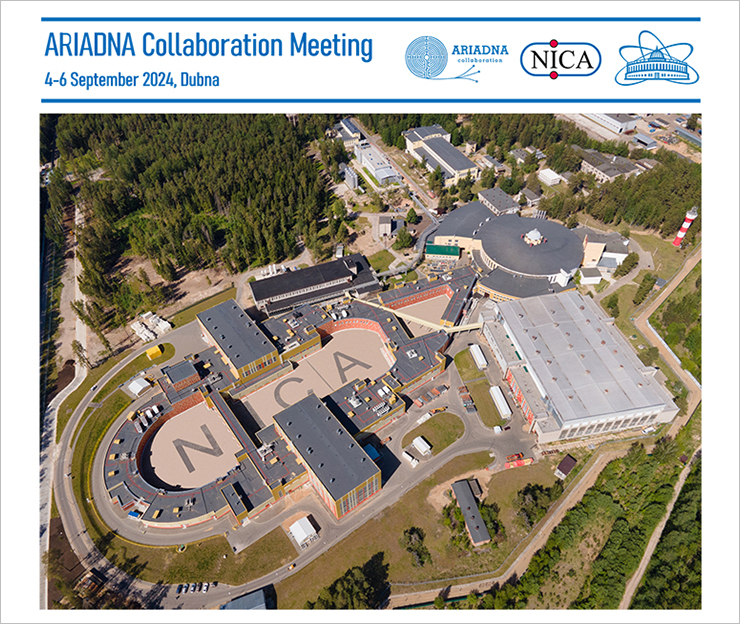ARIADNA Collaboration Meeting on applied research at NICA Complex starts
News, 04 September 2024
On 4 September, the three-day ARIADNA Collaboration Meeting on applied research on accelerated ion beams at the NICA Complex began at the JINR International Conference Centre. The participants are scientists and specialists of 33 organizations from 15 countries, including Armenia, Belarus, Bulgaria, Cuba, Egypt, India, Japan, Kazakhstan, Mexico, Romania, Russia, South Africa, Turkey, Uzbekistan, and Vietnam. Based on the meeting results, an integrated programme of the collaboration for several years will be developed.
The event focuses on several main areas of the collaboration’s work, particularly applied research in life sciences, biomedicine, radiation materials science, microelectronics testing, and applied nuclear technologies, along with tasks of the ADSR Project.
The main objectives of the Working Meeting are to discuss the potential work plan for the ARIADNA applied research programme ahead of the session at the NICA Complex scheduled for 2025. The participants will talk about the results of the first experiments conducted in late 2022 and early 2023 as part of a commissioning run at the accelerator complex, the expansion of the ARIADNA partner network, and ways to combine the research infrastructure of cooperating organizations with the capabilities of the NICA Project.
An important topic will be developing user infrastructure at the NICA Complex, including setting up locations for installing user equipment, preparing samples, and conducting analytical research. “Creating such infrastructure is an urgent issue that we have been actively working on for the last year and a half. It is now clear that upon coming to ARIADNA, users should have access not only to the beam, but also to the appropriate infrastructure for installing their equipment, preparing samples, and conducting analytical studies immediately after irradiation,” ARIADNA Collaboration Leader, Deputy Head for Research of the VBLHEP JINR Department of Methodological Research and Innovation Oleg Belov said.
During the next session at the NICA Complex, which is scheduled for 2025 and expected to be quite long, researchers will carry out applied research experiments. “We plan to use the Target Station for Long-Term Exposure, which was first tested in an experiment in late 2022 and early 2023. What makes the station unique is that it allows working on high-energy heavy ion beams at 3-4 GeV/nucleon for several months. There are barely any other scientific centres in the world that provide users with extensive opportunities for long-term work on heavy ion beams with such energies for applied tasks,” Oleg Belov commented.
On 6 September, the participants will pay a working visit to the NICA Accelerator Complex. The event will conclude with a round table to discuss the immediate work plans and current organizational issues of the collaboration, including the preparation of the first scientific publications on its behalf, collaboration membership, and the accession of new cooperating organizations from different countries to it.
This is the second Collaboration Meeting this year. 31 May marked the meeting on the implementation of state assignments received by member organizations as part of the support programme of the Ministry of Science and Higher Education of Russia. At the previous meeting, participants presented only part of the work plans for the year within the ARIADNA programme. This meeting is extended, with representatives of each organization set to report on the studies proposed to be implemented in the next 3 to 5 years. “Following several such meetings, we expect to develop a balanced multidisciplinary scientific programme of the collaboration involving the leading scientific centres of Russia and other countries of the JINR partner network,” Oleg Belov noted.
The Russian participants of the meeting include representatives of the leading academic organizations and scientific centres working in space research, materials science, biomedicine, and other key areas of the ARIADNA Collaboration. Among them are employees of Institute for Biomedical Problems of the Russian Academy of Sciences (RAS), RAS Institute of Theoretical and Experimental Biophysics, RAS Kurnakov Institute of General and Inorganic Chemistry, RAS Joint Institute for High Temperatures, RAS Semenov Federal Research Centre for Chemical Physics, Tsyb Medical Radiological Research Centre, etc.
The leading universities are represented by scientific teams from Moscow Institute of Physics and Technology, Skobeltsyn Institute of Nuclear Physics of Moscow State University, Saint Petersburg State University, the Peoples’ Friendship University of Russia, Moscow Engineering Physics Institute, and North Ossetian State University.
The meeting is attended by representatives of the National Autonomous University of Mexico, the Higher Institute of Technologies and Applied Sciences (Cuba), Nagaoka University of Technology (Japan), Bhabha Atomic Research Centre (India), Cairo and Helwan Universities (Egypt), Alikhanyan National Science Laboratory (Armenia), the Institute of Nuclear Physics of the Academy of Sciences of Uzbekistan, the Institute for Nuclear Problems of Belarusian State University (Belarus), iThemba LABS (South Africa), Institute of Space Science (Romania), Institute of Physics of the Vietnam Academy of Science and Technology, the Institute for Nuclear Research and Nuclear Energy of the Bulgarian Academy of Sciences, etc.
“Combining our irradiation expertise and the analytical capabilities of specialised partner organizations is a promising opportunity to achieve interesting results in various aspects of applied radiation technologies, deserving of publication in well-known peer-reviewed journals,” Oleg Belov concluded.
